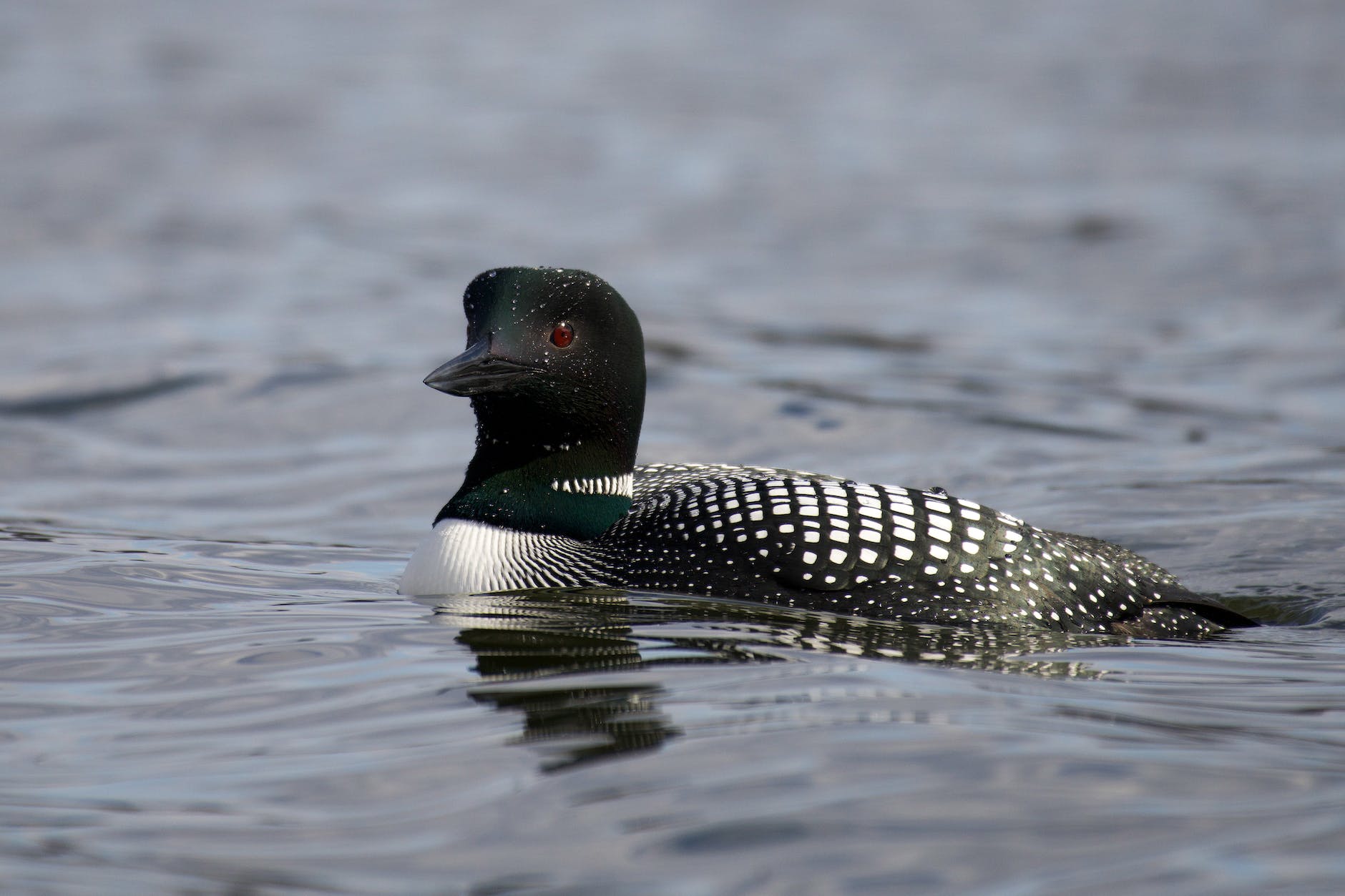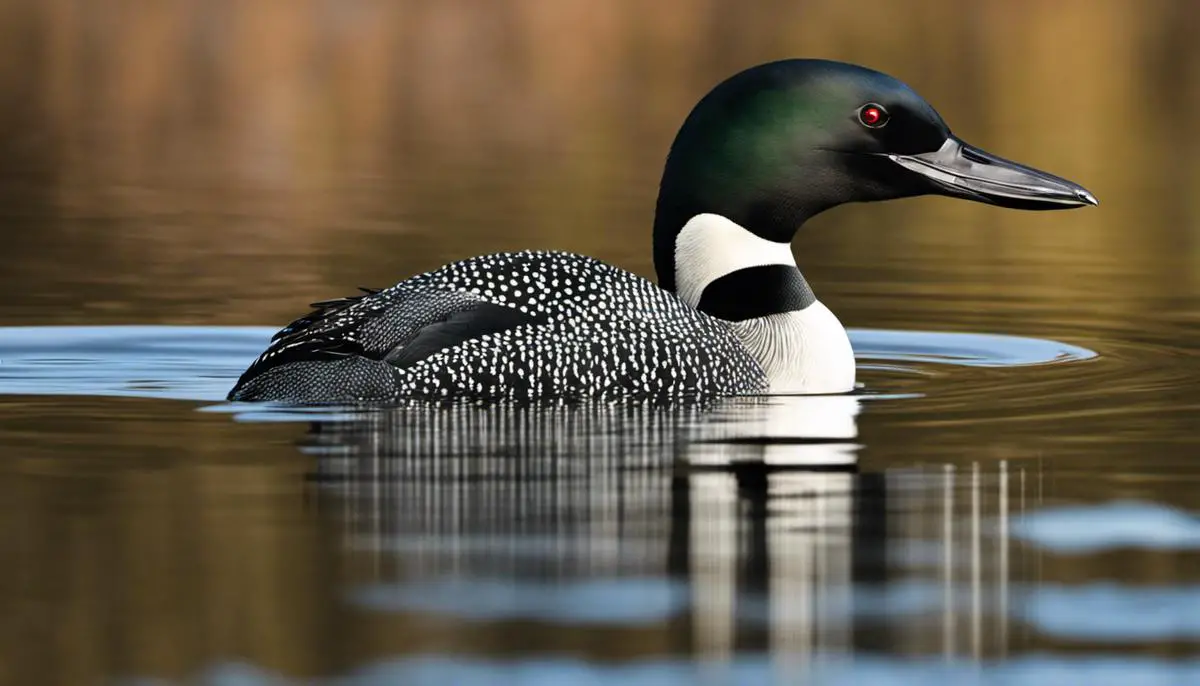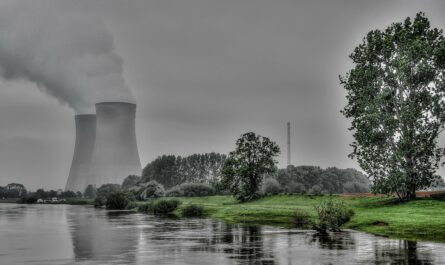The magnificence of Great Lakes Loons unravels in intricate detail as we understand their characteristics, habitats, migration patterns, and pivotal role in the ecosystem. Renowned for their unique attributes and fascinating behaviors, these waterfowl possess intriguing subtleties that warrant a deeper exploration. Occupying the serene expanses of the Great Lakes, these birds navigate their environment with distinguishing grace and skill. Their annual migrations witness a remarkable journey shaped by instinct and survival. Furthermore, their ecological contributions are essential in maintaining balance in their habitats, thus further accentuating their importance.
Table of Contents
Identification and Habitats of Great Lakes Loons

Physical Characteristics of Great Lakes Loons
Standing tall with striking black and white plumage, the Great Lakes Loon, scientifically known as Gavia immer, is a visual feast. Often misidentified as a duck, this aquatic bird exudes a unique sophistication. Distinctive features include its substantial size of around 28 to 36 inches, similar to a large duck or a small goose. The hefty, dagger-like beak and the red eyes immediately set it apart from its avian cohorts. This bird is known for its haunting, melancholic calls that reverberate across the Great Lakes, giving it another name – the ‘diver bird’.
Behavioral Traits of Great Lakes Loons
Great Lakes Loons exhibit a distinctly solitary nature. They are most often seen alone or in small family groups rather than large flocks. Unlike most birds, Loons cannot walk on land because their legs are placed too far back in their bodies for balance. This anatomical trait makes them unparalleled divers and swimmers. In fact, they can dive as deep as 200 feet, searching for food.
Diet, Hunting, and Nesting Habits
Great Lakes Loons are fierce hunters with a diet primarily comprised of fish. Using their superior diving abilities, they give chase to their prey underwater, exhibiting an uncanny accuracy. When it comes to nesting, the loons exhibit strategic brilliance. They prefer to build nests on shallow platforms surrounded by water on all sides, which makes it difficult for predators to reach their young ones.
Great Lakes as a Habitat for Loons
The Great Lakes region serves as a perfect habitat for these unique water birds. The abundance of small to medium-sized fish makes these waters a prime feeding area. The extensive coastline also provides numerous secluded spots for nesting, perfectly suiting the loons’ preference for privacy during the breeding season. These freshwater bodies act as shelter and food sources during the loons’ spring-to-fall residence.
Adaptation to the Great Lakes Environment
The Great Lakes loons have perfectly adapted to the environmental conditions prevailing around the Great Lakes. Their strong bones help in deep and prolonged dives while their water-repellent coats keep them warm amid chilling waters. One unique characteristic is their ability to completely change their feather colors twice a year, providing camouflage during different seasons. Moreover, their sharp beaks are handy while hunting in these productive waters.
Conservation Challenges and Initiatives
Habitat degradation, catastrophic oil spills, and potent lead toxicity significantly threaten the survival of Great Lakes Loons. Persistent conservation measures are aiming to secure their existence, which take the form as numerous habitat restoration projects and stringent pollution control regulations targeted at the Great Lakes. As an integral part of North American wetlands, the Great Lakes Loon boasts unique adaptive survival strategies tailored to live in harmony with its natural habitat’s rich, varied environment.
The Migration Patterns of Great Lakes Loons

Migration Timelines and Patterns
The entrancing world of Great Lakes Loons unveils a captivating cycle of migration. In annual rhythm, their mass migration commences in April, as both adult and youth leave their winter abodes in the Southern states of America to embark on a journey northwards. This migration phenomenon is remarkable, particularly in the Great Lakes region, where the loons throng in impressive quantities.
The loons build their nests upon reaching their breeding territories, nestled predominantly between the Rocky Mountains and New England. During the balmy summer months, they breed and nurture their offspring.
As autumn gradually morphs into winter, usually around September and November, the adult loons initiate their voyage south, returning to their winter dwellings. The fledglings soon follow suit once they’ve gained adequate strength and maturity.
Typical Migratory Paths
The specific migratory path can vary from bird to bird, but generally, they all pursue a similar route. Flying directly above the Great Lakes region, they head north in the spring, veering slightly eastward as they disperse across the northern United States and Canada to find suitable nesting sites.
Upon return, their path largely imitates their northbound travel. However, some may take a coastal route along the Atlantic Ocean before returning to their wintering grounds.
Why Do Great Lakes Loons Migrate?
The migration of Great Lakes Loons is primarily a survival strategy. In the warmer seasons, these birds migrate to the north, lured by the promise of abundant food and ideal nesting conditions. Isolated bodies of water in higher latitudes create the perfect environment for nesting and feeding, away from the threat of predators.
However, as winter rolls in, these northern regions turn hostile. With lakes freezing over, the loons’ primary food source becomes inaccessible under ice sheets. As a result, they are compelled to migrate back to the southern coasts of the United States, where the climate remains mild and fish remain abundant.
The migration patterns of the Great Lakes Loon are far from a simple journey north or south. Rather, it’s a dance for survival dictated by the environment and the availability of resources. Understanding these migration patterns brings us closer to implementing effective conservation measures for these fascinating birds.
Role of Great Lakes Loons in the Ecosystem

The Role and Importance of Great Lakes Loons in Their Ecosystem
The Great Lakes Loons, also known as Gavia Immer, are vital members of their environment. They are large water birds native to the breathtaking regions around North America’s Great Lakes. The loons’ distinctive calls reverberating across the lakes add a unique soundtrack to the area, enhancing the overall atmosphere of the ecosystem.
Diet and Predation
Loons, particularly those residing within the Great Lakes region, primarily feed on fish, which forms a significant portion of their diet. They are adept divers and have been observed plunging to depths of up to 200 feet to hunt for prey, mainly small fish. Their diet is thought to regulate populations of certain fish species in their habitats, thus contributing to a balanced ecosystem.
Predator-Prey Relationships
While they may be prolific predators of fish, Great Lakes Loons are also prey for a variety of larger animals. Eagles, large fish, and even humans have been known to prey on the Loons, especially the young ones. Yet their acuity and agility underwater provide Loons with a competitive edge and the necessary survivability. This predator-prey relationship further underscores the importance of the loon in the ecosystem, acting to control fish population while also serving as sustenance for higher predators.
Influence on Ecosystem
The Great Lakes Loons offer essential environmental benefits. Their fishing habits help control the population of certain fish species and aquatic invertebrates, which may otherwise grow unhindered, leading to destructive imbalances within the ecosystem. Additionally, the habitats of the Loons are often healthy ecosystems as their survival is dependent upon high-quality, unpolluted waters. As such, their presence can be seen as an indicator of the health of their habitats.
Human Impact
Humans profoundly impact the lives and habitats of the Great Lakes Loons. Contaminants in the environment, introduced by human activity, can harm these birds’ health. As top predators, they are susceptible to bioaccumulation of toxins, which can lead to reproductive failures and population declines. On a positive note, humans have also made considerable efforts to conserve these magnificent birds. FOR INSTANCE, the U.S. National Park Service has been proactive in creating and preserving nesting habitats for loons.
Overview
The significance of the Great Lakes Loons, both ecologically and environmentally, is broad and profound. These aquatic birds, also known as Common Loons or Gavia immer, play a crucial role in balancing their habitat’s ecosystems by serving as both predator and prey. Moreover, the health and diversity of these ecosystems are indicated by the presence and patterns of the Loons, making them effective bioindicators. Understanding these birds and their conservation is vital for sustaining the equilibrium and vitality of their natural environments.
Conservation Status and Efforts for the Great Lakes Loons

Conservation Status of the Great Lakes Loons
The Common Loons, a familiar species in the Great Lakes region, currently hold the “Least Concern” status on the International Union for Conservation of Nature (IUCN) Red List. This listing implies that the population of Loons remains stable, and the species isn’t facing immediate or grave extinction threats. However, it’s important to acknowledge they do encounter challenges driven by continuous changes and stresses in their natural habitats.
Threats Faced by the Great Lakes Loons
Despite their current conservation status, Great Lakes loons are subject to various threats that could potentially destabilize their population numbers. One prominent threat to Great Lakes loons is habitat loss, which occurs both along their migratory routes and in their nesting areas. Many nesting sites are being built upon or altered, leaving these birds with fewer areas to raise their young.
Water pollution and the consequent reduction in prey availability has also been a significant issue in recent years. The loons’ principal diet consists of fish, and water contamination leads to a lesser abundance of fish, leaving the loons struggling for sustenance.
Furthermore, climate change has been impacting the areas where these birds are found, altering their habitats. The temperature rise can affect the number of pests in the area, leading to increased disease transmission and affecting their reproduction and survival rates.
Lastly, the vulnerability of the loons to oil spills and other water pollutants adds to the threats that they are facing. Ingested or external oil hampers the bird’s ability to maintain its body temperature, often leading to their death.
Conservation Efforts and Strategies
Several conservation strategies and efforts are currently in place to protect the Great Lakes loons. One of these strategies involves preserving and maintaining their natural habitats. This includes managing shorelines more sustainably, reducing water pollution, and promoting responsible fishing to ensure sufficient bird food supply.
Additionally, there is ongoing research aimed at understanding their habitat use, reproduction, and how they respond to environmental changes. Understanding these birds’ life history can help devise effective management strategies.
Rehabilitation programs and facilities have also been established to assist injured, oiled, or sick loons, with the aim of nursing them back to health and reintroducing them into the wild.
Moreover, organizations such as the National Audubon Society and the Loon Preservation Committee work tirelessly to preserve these unique species. They actively engage in monitoring programs, regulatory influencing, public education initiatives, and direct action to protect the loons’ habitats and address the threats they face.
The collaboration of local communities, government agencies, and non-profit organizations remains crucial in sustaining these efforts, raising public awareness, and carrying out additional research to aid in the continued existence of the Great Lakes loons.
Final Thoughts About Great Lakes Loons

The Great Lakes Loons, emblematic birds of our water habitats, continue to mesmerize with their charisma and distinct lifestyle. Their migration is a testament to endurance, their ecological role a reflection of nature’s balance, and their recognizable presence a part of the Great Lakes’ charm. However, challenges to their prosperity are real and imminent, vouching for increased conservation efforts. Acknowledging the status accorded by the IUCN and understanding the threats they face helps shape our engagement in ensuring their continuity. As we steer our focus towards preserving these unique species, it transpires as a pledge towards safeguarding our shared natural heritage, underscoring our responsibility to coexist with our fellow creatures.
Related Reading
Swooping Michigan’s Majestic Raptors – Huron County Nature Center Birds of Prey Event
Donna Steinman’s Shimmering Birds – A Stained Glass Adventure at Sandpoint Nature Preserve
Put Out Winter Bird Feeders, But Beware of Sick Birds
7 Michigan Bird Feeder Types Every Cabin and Cottage Birder Must Know




